Welcome to Athens (Piraeus) cruise port guide! (Post updated: January 2024)
Nestled in the Saronic Gulf in the southeast of Greece, the port of Piraeus is the gateway to the ancient city of Athens, the capital of Greece and the birthplace of democracy.
With its majestic Acropolis, numerous museums, centuries-old sites, and historic landmarks, Athens is one of the most ancient cities in Europe and a frequent stop in Mediterranean cruise itineraries. In this Athens travel guide, read about:
- Athens cruise port (Piraeus cruise terminals, local transportation, how to get from Piraeus to Athens)
- 11 best things to do in Athens port (including shore excursions)
- What to explore in the city of Piraeus (within walking distance from the port)
If your homeport is Piraeus and you are staying in Athens before or after your cruise, I made a list of the 15 Best Hotels Near the Port of Piraeus (Athens) that you may find helpful!
Visit also our cruise port guides to Mykonos, Santorini, Rhodes, Crete (Heraklion), Chania, Kusadasi
Athens Cruise Port (Piraeus)
Port of Athens is located in Piraeus, an old city located approximately 10 km/6 miles (a 25-30-minute drive) from Athens city center. It is the largest Greek port and one of the largest passenger cruise ports in Europe.
Piraeus is attractive due to its proximity to the Greek capital; it is a major hub for passenger cruise ships, ferries, and cargo ships, and it is also a home port for several ships starting and ending the cruises in Piraeus.
The port of Piraeus has a large ferry terminal offering roundtrip cruises to Greek islands such as Crete, Santorini, Rhodes, Lesbos, Zakynthos, Kefalonia, Samos, and other Mediterranean destinations. In case you are coming on a cruise to Athens, you should come earlier to explore the wonderful sites and attractions this city has to offer.
Piraeus cruise port has 3 passenger cruise terminals that can accommodate up to 11 cruise ships, and each terminal has its own terminal building.
Major cruise lines sailing to Athens Greece include Celebrity Cruises, Royal Caribbean International, Windstar Cruises, Oceania Cruises, Holland America Line, Norwegian Cruise Line, Seabourn Cruise Line, Virgin Voyages, Azamara, and Viking Ocean Cruises.
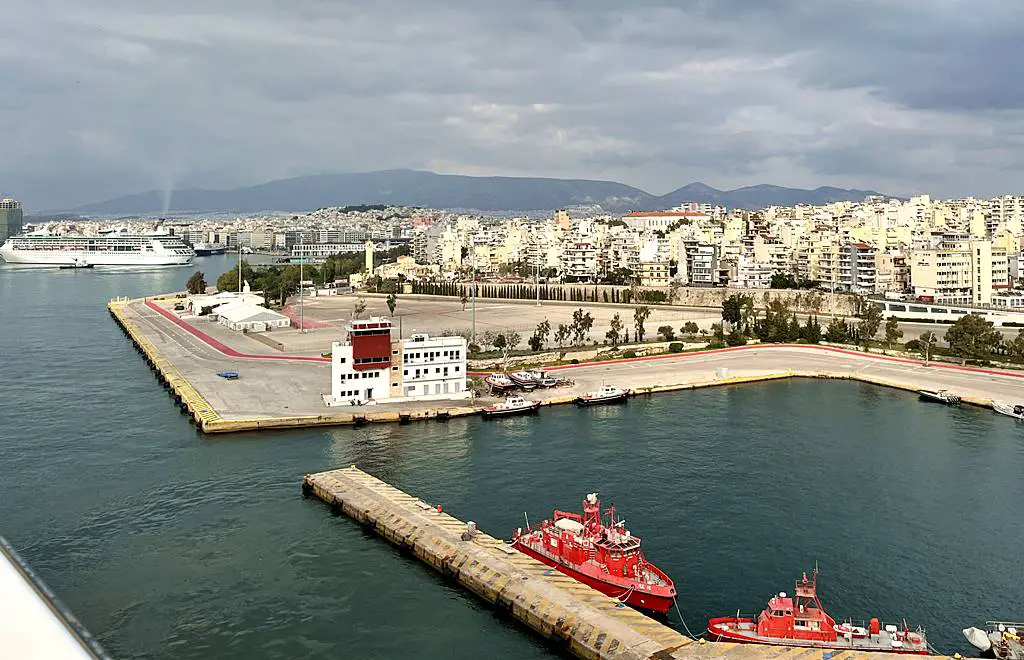
1. Terminal A (Miaoulis)
Miaoulis is the main terminal and it can accommodate up to 12.000 passengers (2 or 3 ships simultaneously). It has a terminal building with modern facilities including free Wi-Fi, air conditioning, duty-free stores, public phones, cafes, souvenir shops, ATMs, currency exchange, customs office, immigration, police, and check-in/departures. The terminal has a taxi rank and large parking that can accommodate up to 80 buses.
Terminal A is the closest one to the town of Piraeus. You can reach Piraeus downtown within a 15-minute walk, as well as the metro station where you can catch line 1 to go to Athens. As soon as you leave the terminal you will see buildings of the city and there is a nearby waterfront lined with some restaurants, shops, and cafes.
2. Terminal B (Themistocles)
This terminal is the furthest one from the city and consists of 2 long quays able to accommodate mega cruise ships (4.500+ passengers). The terminal building is situated across Quay Themistocles and is primarily used for turnarounds (for passengers embarking and disembarking in Piraeus).
The terminal building consists of facilities including an arrivals/departure hall, customs office, immigration, police, air-conditioning, free Wi-Fi, public phones, and a duty-free shop. There is a parking area and a taxi rank available next to the terminal.

3. Terminal C (Alkimos)
Cruise ship terminal C is located along the quay between Terminals A and B and can accommodate up to 3000 passengers at a time. The terminal building features facilities including check-in, arrivals/departure hall, customs office, police, immigration, air-conditioning, free Wi-Fi, a taxi rank, and a parking area for buses and taxis.
Hop on Hop off buses are available in front of each terminal, ready to take you to Athens city center.
Watch my Athens (Piraeus) Cruise Port Guide YOUTUBE Video!
How to Get to Athens from the Port of Piraeus?
- ON A SHORE EXCURSION – If you are coming to the Greek capital for the first time, the best way to get the most out of your day in Athens is to book a shore excursion. You can book it through your cruise line, or an independent tour operator if you opt for a more flexible schedule and tour flow.
- METRO – The fastest way to get from Piraeus to Athens downtown is by metro. A 90-minute ticket costs 1.20€ and the train station is located approximately 20-30 minutes walk from terminals B and C. The metro ride from Piraeus to Athens city center (Monastiraki metro station) lasts only 15 minutes. To save time, you can take a taxi to the metro station which usually costs no more than 10€ per vehicle one way.
- TAXI – Due to the congested traffic, a ride to Athens can take anywhere from 20-40 minutes. Taxis are metered, however, be ready to negotiate. If you take a taxi from Piraeus to Akropolis, Akropolis Museum, Monastiraki Square, and Syntagma Square, the cost is around 30€ per vehicle one way for each route.
- PUBLIC BUS – Although it is one of the cheapest ways to go to Athens, a bus can be very crowded and time-consuming. To go to Athens, the best option is to use line 040. There is also bus line X80 (Piraeus-Akropolis-Syntagma Express) that connects Piraeus and Athens city center, however, this bus doesn’t run regularly (at least it was out of service when I last visited in June 2023), so I highly suggest you take line 40. The ticket costs 1.50€ and the journey to Athens lasts around 1 hour as there are many stops along the way. The bus stop is near the cruise terminal buildings (OLP cruise terminal gate bus stop is the starting point) and they are quite easy to catch.
- HOP ON HOP OFF BUS – Athens Hop on Hop off sightseeing buses are available at cruise terminals A and B, and there are several different companies offering rides. There are several different routes (Athens route, Piraeus route, Beach and Riviera route) and the buses stop at the major Athens highlights including the Temple of Zeus, Syntagma Square, Monastiraki Square, Acropolis and Parthenon, Acropolis Museum, Panathenaic Stadium, National Archaeological Museum, National Library, Ancient Olympic Stadium, and many others. Check the Athens Hop on Hop off bus tours on Viator and Get Your Guide.
Getting Around Athens Cruise Port
- Get more public transport info at https://www.piraeus.org/
- Athens is an old city with lots of cobblestones and Acropolis is on a hill, which may be challenging for people with walking difficulties.
- The official currency in Greece is EURO (€). Local currency and credit cards are widely accepted. ATMs are available at cruise terminals and in the city.
- Athens International Airport is located about 43 km/27 miles (a 50-minute drive) east of Piraeus cruise port. The port is well connected to Athens International Airport by Metro Blue Line 3 and the ride takes 55 minutes.
- Explore Athens tours and activities
- Book a private transfer to/from the port of Piraeus
- Search the best hotels in Piraeus (Athens)
11 Best Things to Do in Athens Cruise Port
Before I share the best things to do in Athens (Piraeus) cruise port, I invite you to grab your copy of the “Mediterranean Cruise Port Guide”, the most comprehensive guide to 45 Mediterranean cruise ports (including Athens, Piraeus), packed with practical information, expert tips & unforgettable experiences! (PDF format/200 pages)
 A Comprehensive Guide to 45 Mediterranean Cruise Ports
Plan your cruise itinerary in less than an hour and maximize your port experience!
A Comprehensive Guide to 45 Mediterranean Cruise Ports
Plan your cruise itinerary in less than an hour and maximize your port experience!
1. Ancient Acropolis
For first-time visitors, Acropolis Hill is definitely the top pick! Built on top of the hill dominating the historic heart of Athens, Acropolis ranks among the world’s most stunning ancient ruins.
The iconic symbol of the entire archeological complex is the Parthenon, the largest temple of the classical antiquity period dating from 438 BC. With its massive Doric columns and monumental sculptures, the Parthenon is dedicated to the goddess Athena, the city’s patron.
Acropolis consists of several other ruins worth visiting, including the Temple of Athena Nike, the Odeon of Herodes Atticus (the ancient theater built in AD 161), Propylaea (the entrance to the Acropolis), and the famous Erechtheion complex that features the Porch of the six caryatids, one of the most photographed ruins on Acropolis.
If you are visiting Acropolis, make sure you come early in the morning to avoid crowds and hot weather. The entrance ticket to Acropolis costs 20€ and I highly recommend you book skip-the-line tickets ahead of time to avoid lines and crowds at the entrance.
However, by the entrance to the complex, there are instructions on how to book a skip-the-line ticket on-site and the whole process takes 5 minutes, assuming you have internet of course.
If you are coming on a shore excursion, the ticket is normally included in the price. The terrain is uneven and it’s not recommended for guests with walking difficulties.
Explore Acropolis tours and skip-the-line tickets
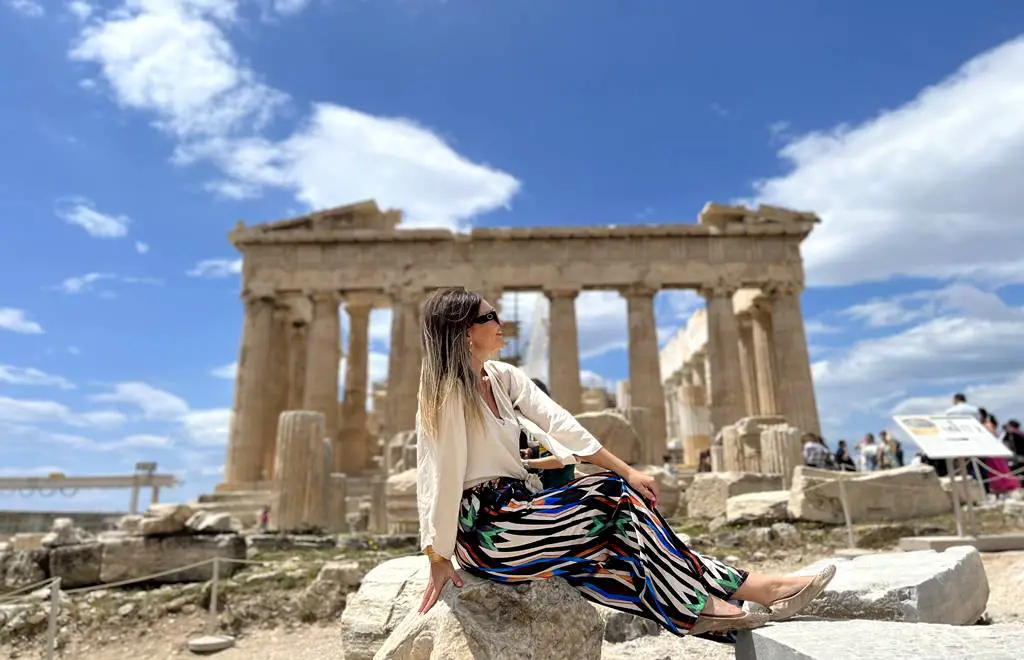
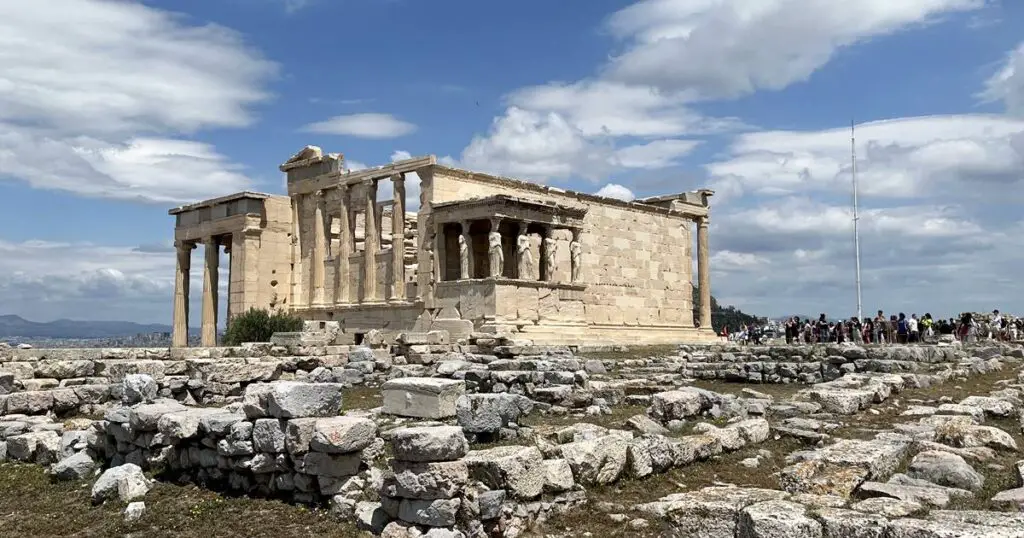
2. Acropolis Museum
The visit to Acropolis wouldn’t be complete without the Acropolis Museum which contains one of the most valuable collections of ancient Greek art in the world. It is located below Acropolis Hill, around 300 meters from the archeological site, and is flat and walkable so guests with walking difficulties can easily explore it. The Acropolis Museum is also wheelchair accessible.
The museum covers a vast area and the facility itself takes at least a couple of hours to explore. Bright halls, modern architecture, and over 4000 priceless objects, paintings, artifacts, and art from the Acropolis archeological site await you in this fantastic museum.
The entrance ticket is 15€ and is bought separately from the Acropolis complex. If you are planning to visit both Acropolis and the museum, keep in mind that it will take half of your day.
Check out Acropolis Museum skip-the-line tickets
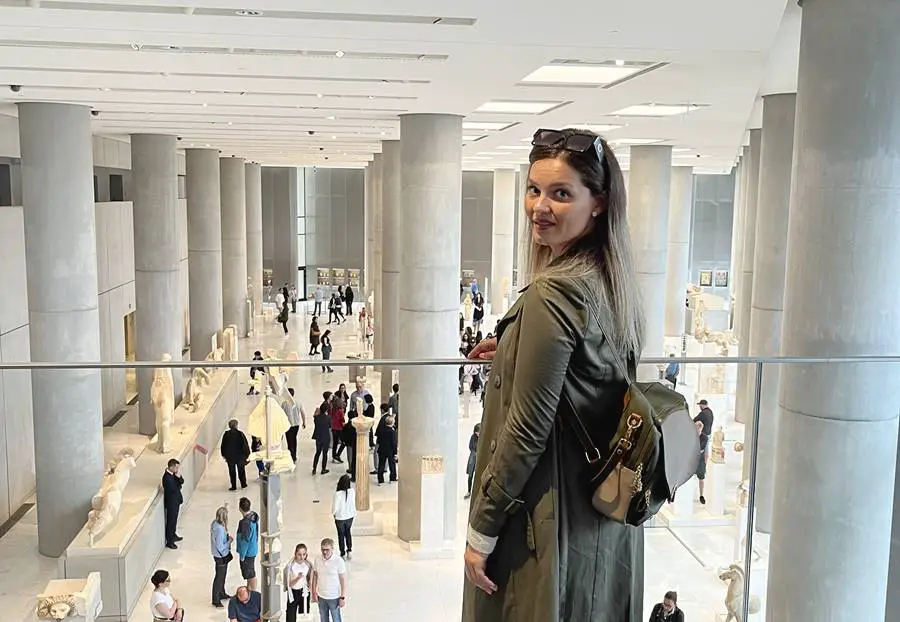
3. Temple of Olympian Zeus
Also known as the Olympieion, the Temple of Olympian Zeus was the largest temple in ancient Greece. It was dedicated to “Olympian” Zeus, a name originating from his position as head of the Olympian Gods. The temple is not as preserved as Parthenon, and you cannot get very close to it.
The famous site once consisted of 104 massive marble columns, but today only 15 columns remain standing. Despite being only the remains, the ruins give you an idea of how grandiose the site used to be in the past.
The Temple of Olympian Zeus is part of the larger Archaeological Site of Olympieion, which also includes the Temple of the Delphinian Apollo and the Law Court at the Delphinion, the gates of the Themistoclean Wall, public baths, and Hadrian’s Arch dating back from AD 131.
The Temple of Olympian Zeus is wheelchair accessible. The site is open daily from 8 am to 3 pm, and the admission fee is 8€.
Explore the Temple of Olympian Zeus tours and activities
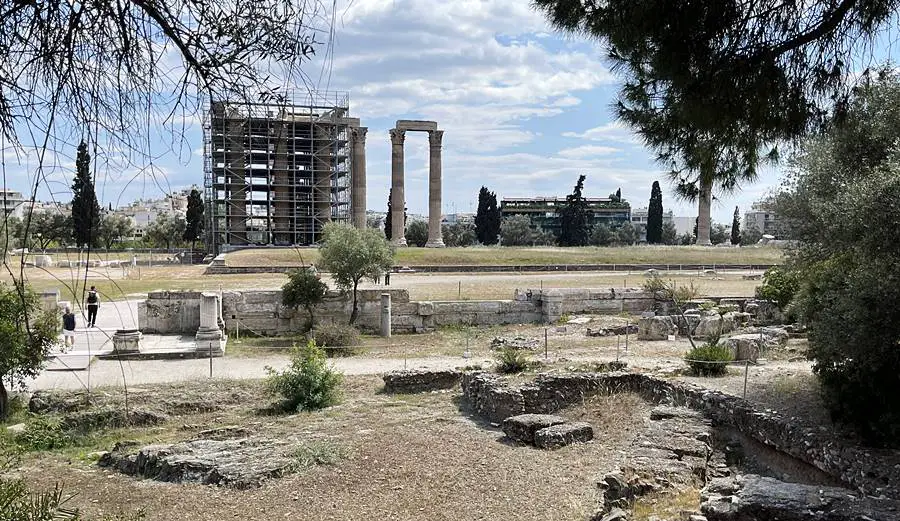
4. Plaka Neighborhood
For those of you who cannot walk uphill to the Acropolis or simply prefer shopping and taking in the local atmosphere, the Plaka neighborhood located between the Acropolis and Ermou Street is a perfect spot to spend a couple of hours.
Plaka is a picturesque historic neighborhood that resembles a Greek island village with its charming mansions with colorful facades, sidewalk cafes, narrow pedestrian streets, small squares, taverns, and authentic shops. Here you can find some great restaurants where you can taste traditional Greek food – a must-do when in Athens!
The neighborhood is flat and easy to walk around, so in case you have difficulty climbing the Acropolis, you can stay and admire the Parthenon from the bottom (it’s visible from the foot of the hill). The majority of Athens sightseeing tours include some free time, and the Plaka quarter is where the tour guides usually drop you off.
Explore Plaka tours and activities
5. Monastiraki Quarter & the Flea Market
Located right next to the Plaka quarter, the Monastiraki neighborhood is one of the most famous shopping areas in Athens, known for its old flea market where you find everything your heart desires!
Look up and you’ll be blown away by the beauty of the hilltop Acropolis overlooking the neighborhood and Monastiraki Square, a central area near the flea market.
Monastiraki is a more casual district than the neighboring upscale Plaka quarter, and here you will find jewelry, clothing, authentic souvenirs, specialty stores, everyday goods, and a lot of restaurants where you can grab gyros or any other traditional Greek dishes.
You will find that prices here are cheaper than in most places in Athens, however, beware of pickpockets as the area is quite crowded and chaotic.
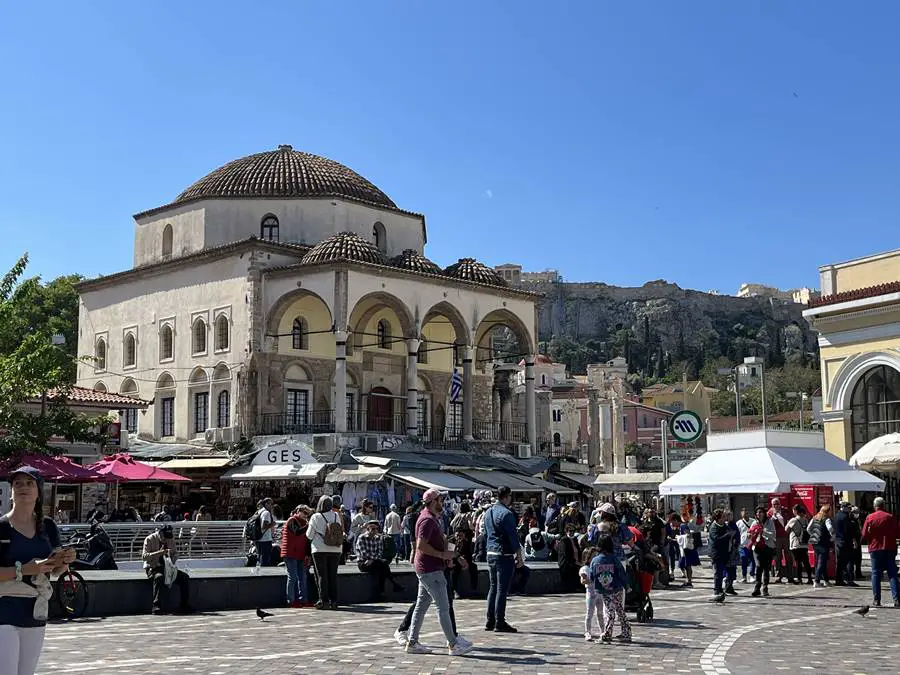
Here you will find the main shopping street in the city – Ermou Street, a shopping paradise offering a wide range of stores, from authentic handicrafts and souvenir shops to high-end designer stores and internationally recognized brands. Monastiraki Subway station is located at Monastiraki Square, so you should get off here if you want to explore Ermou Street and the historic heart of Athens on your own. Monastiraki’s major attractions include:
- Tzisdarakis Mosque
- Church of the Pantanassa
- Hadrian’s Library
- Roman Agora
- Ancient Agora
Check out Monastiraki tours and activities
6. Syntagma Square
The iconic Syntagma Square is the central square in Athens facing Ermou Street (the main shopping street) on one side, and the Hellenic Parliament and the Tomb of the Unknown Soldier (The Changing of the Guards every day at 11 am is an interesting sight) on the opposite side.
Syntagma Square is a common location for public gatherings, protests, and celebrations, and serves as a major transportation hub in Athens. The Syntagma Metro Station, located beneath the square, is a central interchange point for the city’s metro system.
Hop on Hop off buses as well as a tourist train depart from here. The square and its surroundings come to life in the evening, with numerous bars and restaurants offering a lively atmosphere for both locals and tourists.
Explore Syntagma Square tours and activities
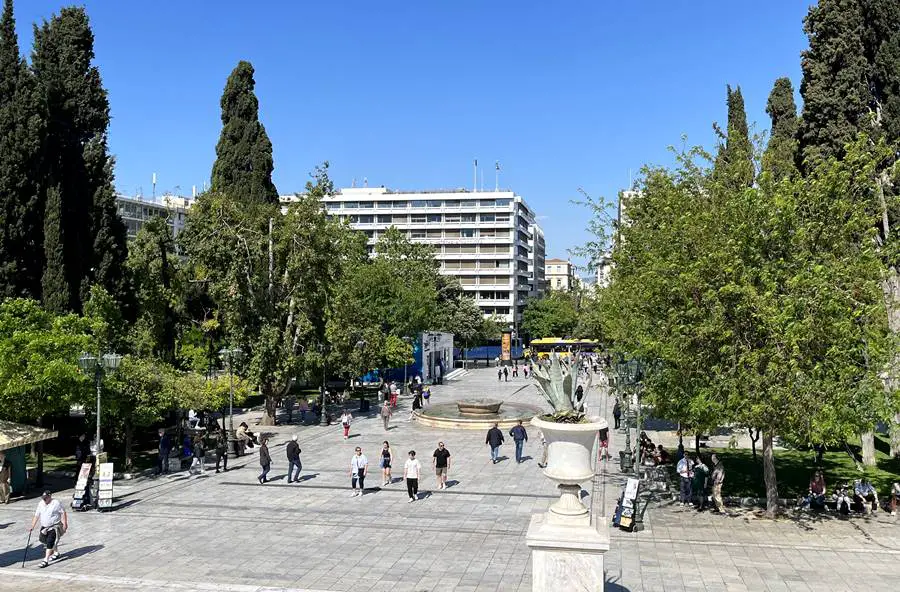
7. Panathenaic Stadium
Only 10 minutes walk from the Plaka neighborhood and Acropolis, this stadium was ancient Athens’s largest structure that could accommodate 60.000 spectators.
Today, visitors can visit a replica of the original stadium which was rebuilt for the first modern Olympic games in 1896. It is a popular spot hosting ceremonial events and live concerts.
The entrance fee is 10€ and it also includes the entrance to the museum dedicated to the Olympic Games.
Check out Panathenaic Stadium tours and activities
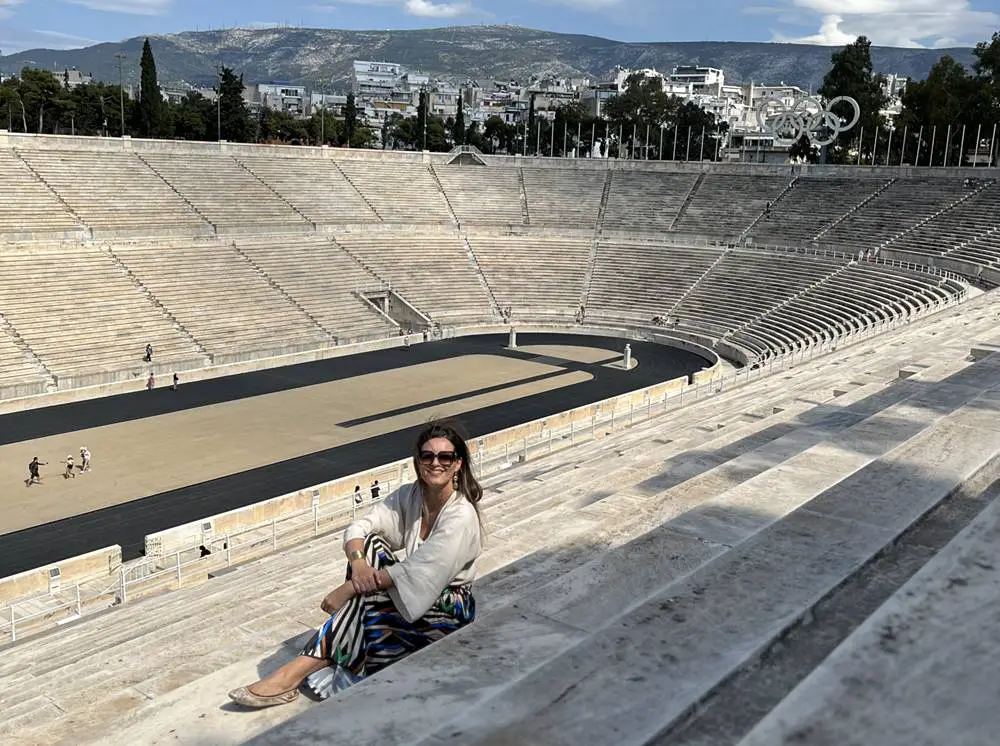
8. Athens City Sightseeing by Hop on Hop off Bus
Athens has so many archeological sites, historic landmarks, museums, and attractions that one day is simply not enough. However, if you are staying for a limited time in Athens and you want to make the most of your visit without joining a guided shore excursion, Hop on Hop off buses give you the flexibility and access to the main city sights in a short time.
The buses depart every 15-30 minutes and a few different companies offer the service. You can board Hop on Hop off bus right at the cruise terminals, or even book a shore excursion if offered by your cruise line.
Some of the stops include Syntagma Square, Benaki Museum, Museum of Cycladic Art, Acropolis & Acropolis Museum, National Library, National Archaeological Museum, Panathenaic Stadium, and Temple of Olympian Zeus.
9. Athens Bike Tour
Although it might not be considered a highlight, Athens bike tours are very popular for those who love active adventures and rank among the bestselling tours in this port of call.
If you prefer an action-packed vacation, go for an amazing bike ride through Athens with many stops along the way to hear the stories of the city’s wonderful sights such as Hadrian’s Arch, Temple of Zeus, Acropolis, and the Parthenon.
These tours require comfortable shoes and as a recommendation, lots of water and sunscreen since the city gets warm in the later mornings.
Explore Athens bike tours and activities
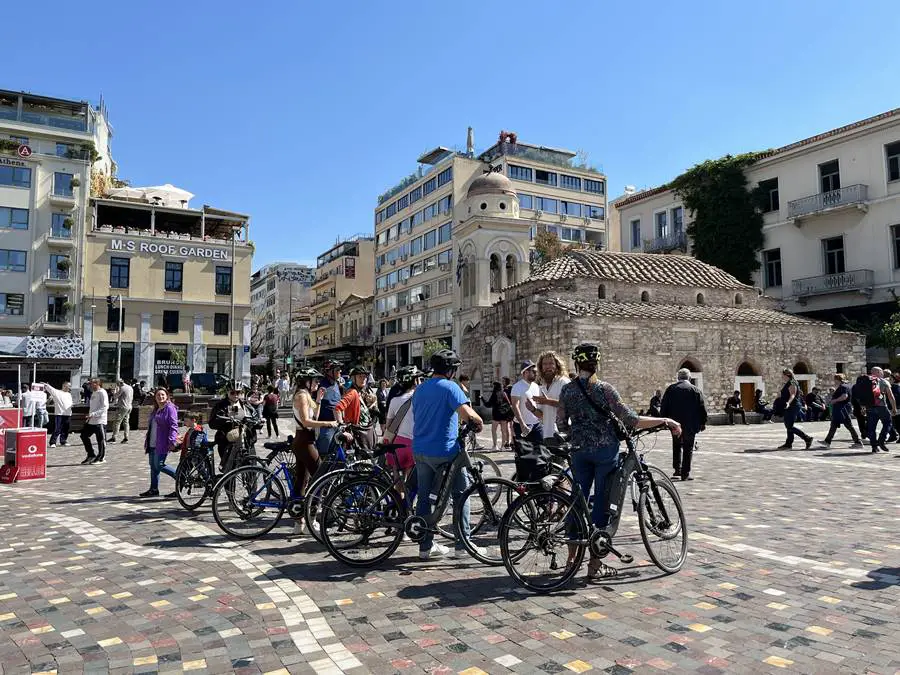
10. Mount Lycabettus
If you want to capture the most breathtaking pictures of Acropolis, the city of Athens and its coastline, head over to the city’s highest point – Mt Lycabettus (Lykavittos), a limestone hill rising 886 feet (270 meters) above the Greek capital.
The best way to get there is to take the funicular that runs daily from 9 am to 2:30 am. The base station is on the corner of Aristippou and Ploutarchou streets, and funiculars run every 15 to 30 minutes, depending on the season and time of the day.
Each can accommodate up to 34 passengers, and the ticket is 10€ round-trip/7€ one way per person. On the cable car top station, you can visit St. George Church (Agios Georgios) and enjoy the view from the terraced restaurant and observation point.
For adventurers and those of you in good shape, you can also hike to the top, but in that case, make sure you wear appropriate clothing and bring a lot of water.
Explore Mount Lycabettus tours and activities

11. Ancient Corinth & Canal Cruise
If you have already been to Athens, this day trip might just be the perfect option for you! This tour will take you on a 1-hour drive along the coast highway to the famous Corinth Canal which is one of the biggest man-made canals in the world dating from the 19th century.
The canal connects the Gulf of Corinth (Ionian Sea) and the Saronic Gulf (Aegean Sea) and separates the Peloponnese from the Greek mainland.
Corinth Canal is 76 feet wide and 26 feet deep, which makes it difficult to navigate for large ships. Carved into a massive rock, the canal is today mainly used for recreational activities and as a tourist attraction.
Once you come to Corinth, guests normally board a boat in the Greek village of Isthmia for a 45-minute ride through the canal. Make sure you bring a good camera, as the sights of the rising sheer rocks are truly impressive!
This day trip normally includes a visit to the ruins of the town of Corinth, known for one of the oldest Doric temples in Greece – the Temple of Apollo, built around 560 BC.
You will visit the Archeological Site with the Archeological Museum of Ancient Corinth, marvel at the ancient buildings, temples, archeological findings, and artifacts, and learn about this important ancient city in Peloponnese.
Check out Ancient Corinth & Canal Cruise tours from Athens
What to Explore in the City of Piraeus
- Archeological Museum of Piraeus – This museum is a true hidden gem of Piraeus and a perfect place to explore if you want to learn about the history of the town which used to be one of the major commercial centers of the Eastern Mediterranean and an important naval base of ancient Athens. Housed in a two-story building, this impressive museum has several different sections including a naval dockyard, pottery, archeological findings from everyday life, the bronze statues of Piraeus, religious life, plastic art of Hellenistic and Roman periods, and more. You can walk to the Archeological Museum (a walk from Terminal A takes 20-30 minutes), or you can take a Hop on Hop off bus (Piraeus route) that normally stops there.
- Hellenic Maritime Museum – Anyone interested in maritime history will love to visit this lovely museum, situated only a 10-minute walk from the Archeological Museum of Piraeus. Founded in the mid-20s, this small museum boasts an attractive location overlooking the Zea Marina and features more than 2500 exhibits and charts dating even from the prehistoric era. Discover the naval and nautical history of Greece and admire a large collection of ship models, artifacts, paintings, and thousands of naval books and charts that were preserved and kept in this museum.
- The Church of Saint Nicholas is one of the most beautiful Greek Orthodox churches in Piraeus and an iconic landmark of the town. This remarkable architectural gem and an important religious site will enchant you with its beauty and is super close to the port itself (a 15-minute walk from Terminal A). The facade of the church, the elegant staircase, as well as the bright blue dome, really stand out from its surroundings, and it’s a location worth visiting.
- Another religious jewel is the Agia Triada Cathedral (Holy Trinity). Situated in the heart of Piraeus, this neo-Byzantine Greek Orthodox Cathedral dates from the 18th century and boasts marvelous architecture from both exterior and interior.
- Electric Railways Museum – Located at the main train station of Piraeus, this tiny museum displays an impressive collection of old railway equipment, photos, pamphlets, and authentic conductor costumes.
- Taste Local Seafood – Although traditional Greek cuisine is mostly known for its delicious meat specialties (gyros, souvlaki…), the city of Piraeus boasts a wide variety of seafood restaurants where you can taste some of the freshest and tastiest seafood in the world for reasonable prices. You can find numerous restaurants, taverns, and cafes on the city’s waterfront where you can taste all sorts of dishes (If you come across a pan-fried fish coated in butter – go for it, as that’s one of the local specialties!). For the best harbor views, Mikrolimano Bay and Zea Marina offer spectacular views of luxury yachts, picturesque fishing boats, and old houses lined with the coast.
- Piraeus Fun Blue Train – The best way to explore Piraeus highlights is to hop on a local sightseeing train that waits for you at cruise terminals. They stop at the major city attractions including Pasalimani (Zea Marina) – the main marina of the town, Piraeus Municipal Theater, the Archeological Museum, the Maritime Museum, and many others.
Check out Piraeus tours and activities
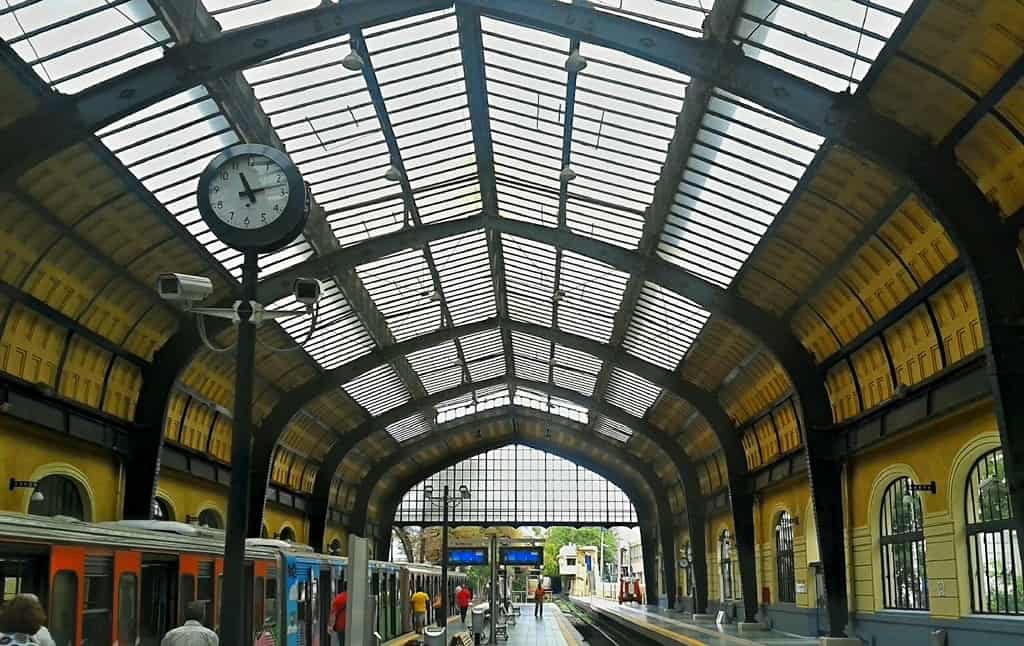
To Wrap Up
If your cruise itinerary includes Athens, I strongly advise you to carefully plan your day to maximize your port experience. If you are embarking or disembarking in Athens, I definitely think you should consider staying a couple of days more so you can get the most out of the wonderful Greek capital.
Visit also our cruise port guides to Istanbul, Kotor, Barcelona, Marseille, Rome (Civitavecchia), La Spezia (Cinque Terre), Villefranche
You may also like our cruise port guides to the Mediterranean, Caribbean, Western Europe, Baltic & Scandinavia, USA & Canada, Australia & New Zealand
Don’t miss out on the opportunity to enhance your Mediterranean cruise experience with our “Mediterranean Cruise Port Guide“- your ultimate companion to discovering the region’s hidden treasures and creating unforgettable memories; click below to purchase your copy today and embark on the voyage of a lifetime!

Ultimate Guide to Mediterranean Cruise Ports
Plan your Cruise Itinerary in Less than an Hour and Maximize Your Port
Experience!
This article may contain affiliate / compensated links. For full information, please see my disclaimer here.


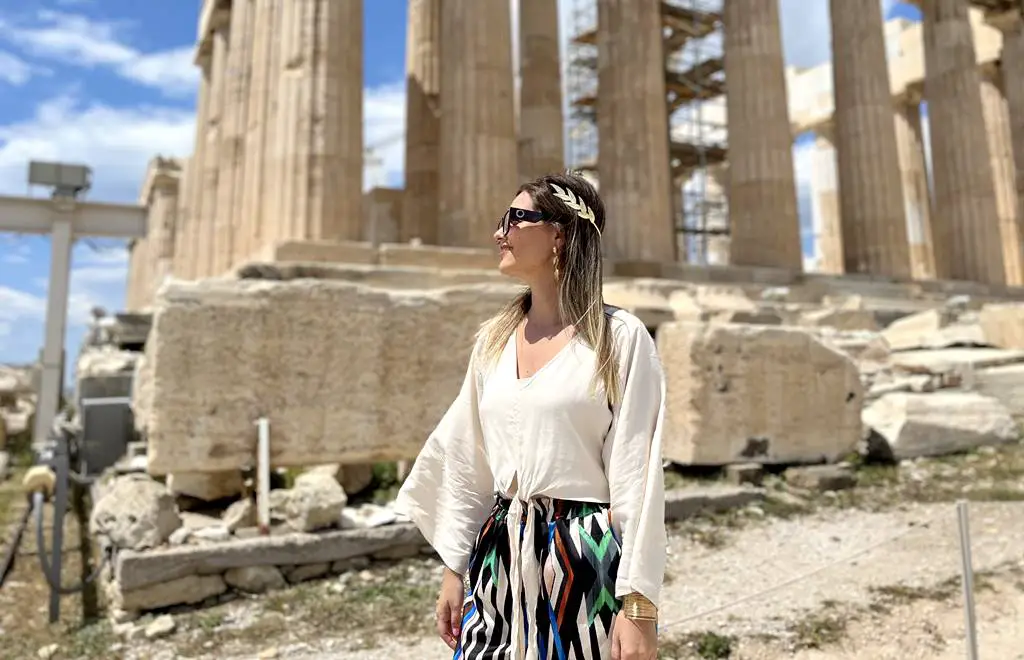

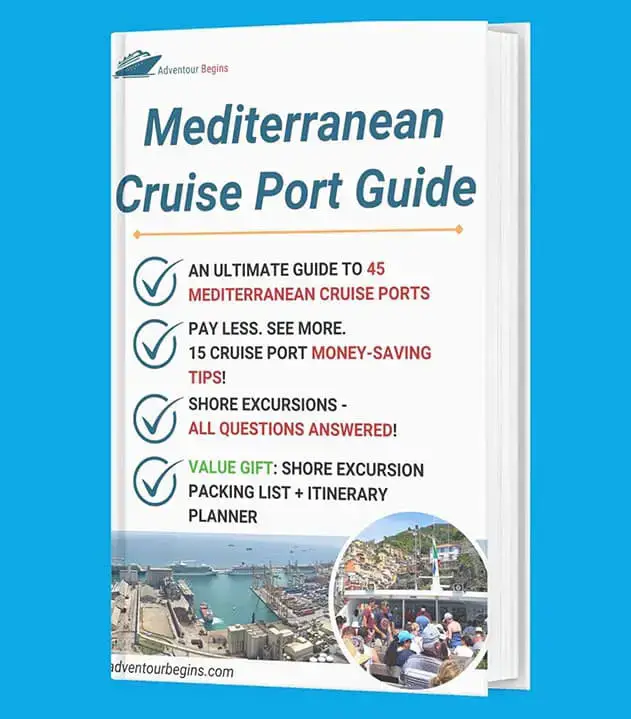



After reading that some of the sites are only accessible by many stairs, can you please tell me which sites would not be advisable for someone with an extreme fear of heights?
I am also extremely afraid of heights 🙂 But don’t worry, Acropolis is on the hill but it’s ok, generally in Athens there are no “dangerous”/high places I can think of… Enjoy your trip!